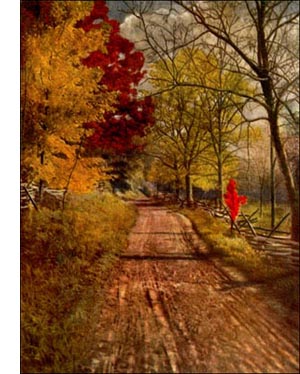Western Larch Tree
 Western Larch (Larix occidentalis, Nutt.)-A pyramidal tree, with naked trunk and sparse foliage at the top, 100 to 250 feet high. Bark cinnamon-red, broken into thick plates, with thin, scaly surface. Wood heavy, hard, strong, close grained, red, durable. Buds small, globose, brown, hoary. Leaves stiff, sharp, keeled below, triangular, pale green, turning yellow in autumn. Flowers : pistillate sessile, oblong ; bracts needle pointed ; staminate stalked, yellow, globose. Fruits large, oval cones ; scales hoary at base ; bract needle pointed, shorter than scale. Preferred habitat, low, wet soil, at 2,000 to 3,000 feet elevation. Distribution, southern British Columbia in Cascade Mountains to Columbia River; in Blue Mountains of Washington and Oregon; to western Montana. Uses: Best wood among conifers. Used for furniture and interior finish, railroad ties, fence posts.
Western Larch (Larix occidentalis, Nutt.)-A pyramidal tree, with naked trunk and sparse foliage at the top, 100 to 250 feet high. Bark cinnamon-red, broken into thick plates, with thin, scaly surface. Wood heavy, hard, strong, close grained, red, durable. Buds small, globose, brown, hoary. Leaves stiff, sharp, keeled below, triangular, pale green, turning yellow in autumn. Flowers : pistillate sessile, oblong ; bracts needle pointed ; staminate stalked, yellow, globose. Fruits large, oval cones ; scales hoary at base ; bract needle pointed, shorter than scale. Preferred habitat, low, wet soil, at 2,000 to 3,000 feet elevation. Distribution, southern British Columbia in Cascade Mountains to Columbia River; in Blue Mountains of Washington and Oregon; to western Montana. Uses: Best wood among conifers. Used for furniture and interior finish, railroad ties, fence posts.The Western larch holds an enviable rank among American forest trees. It is counted superior to all other conifers in the value of its wood, which seems to have all good qualities. Its hardness, fine colour and brilliant polish commend it to the maker of furniture. As fence posts and railroad ties it lasts indefinitely, compared with other timber. Trees 6 feet in diameter and 200 feet high are quite common in this species. Of such mighty trunks a very small outer layer is sap wood.
For the first fifty years this larch is pyramidal, but thinly branched. From this age on the lower limbs die, and the tree at length presents a bare trunk with a mere wisp of a top. What wonder that growth is slow! One log 18 inches in diameter showed 267 rings. In its fiftieth year it was but 9 inches in diameter. The last inch of wood was eighty years in forming. No other tree has so inconsiderable a foliage mass to maintain so large a body.
The brown gum that exudes from wounds in the bark of this tree seems not to be resinous, though it smells like turpentine. It is sweet and resembles dextrine. As dextrine is a soluble form of starch, the Indians find this wax a very nutritious article of food.
The Western larch shows little merit as an ornamental tree on the eastern side of the continent. In Europe it does better, and is planted for timber as well as for ornament. I cannot grieve that this magnificent wild tree scorns to adapt itself, or even its seedlings, to the compass of a sunny suburban lawn in the East. People who truly wish to know it must go to the wild forest parks we own in the great Northwest. There waits for us with infinite patience (and an indifference quite as large), the grandest larch tree in the world!